
| Walk 4 - Pouakai Circuit |
|
|
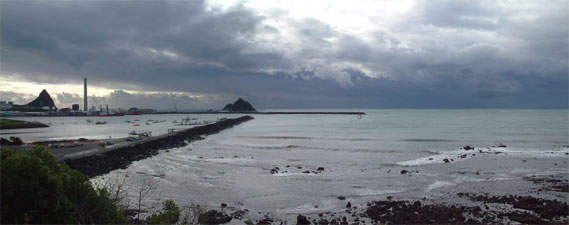 Storm clouds over Port Taranaki |
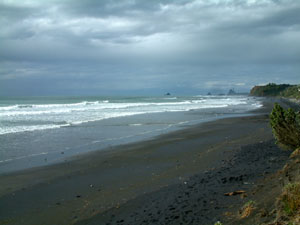 The black sand beaches of Taranaki |
|
Day 1 (North Egmont to Holly Hut) |
 Humphreys Castle points the way |
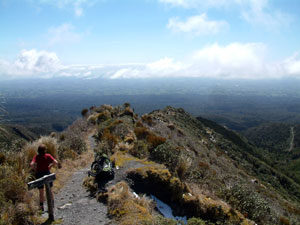 On The Razorback looking out over the plain |
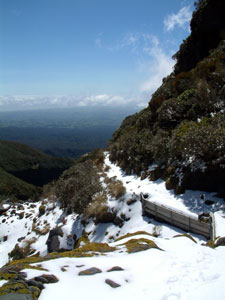 Snowy track on the north face |
Leaving the North Egmont Visitor's Centre the track quickly climbed via series of steps through first, cloud forest, and then, sub-alpine scrub. High above the silhouette of Humphrey's Castle, a lava outcrop, pointed the way to the peak of Taranaki. Soon the steps ended and we found ourselves on a track that snaked along The Razorback ridge, leaving our foot prints in the melting remnants of the last snowfall. |
||
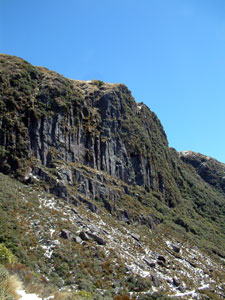 Dieffenbach cliffs - the crumbling end of an old lava flow |
Turning westward, we began a slower climb along the snow covered track to our highest point (1310m) before crossing under the impressive 140m Dieffenbach cliffs, the glacier-like end of an old lava flow. Our passage across the north face of Taranaki continued on a slow descent, past a mini-cirque opening up views to the peak, and across the Boomerang Slip. a major landslide that made for an interesting passage. |
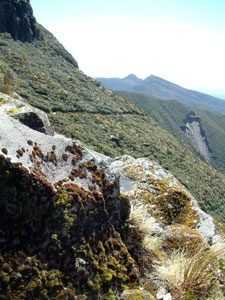 Track under the Dieffenbach cliffs |
 Can you spot the well-camouflaged wildlife? |
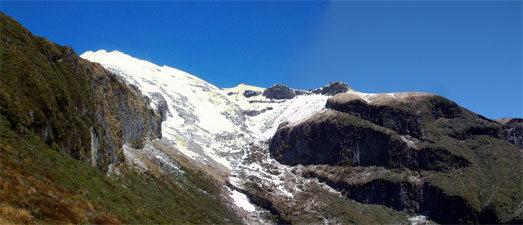 An impressive cirque formed by lava cliffs |
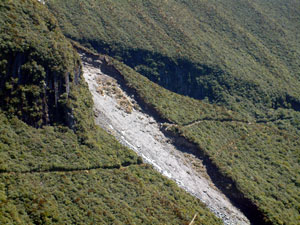 The Boomerang Slip |
|
|
|
|
|
|
||
|
|||
Day 2 (Holly Hut to Pouakai Hut)
|
|
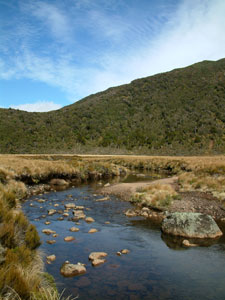 Stoney River draining the Ahukawakawa Swamp |
 Old man cedar |
As soon as we had crossed the swamp, the 300m climb of the Pouakai range commenced in earnest, following a narrow razorback ridge, where landslides had further reduced the width to under a metre in places. This was the most dangerous part of the walk, not because of the landslides, but because the views behind of Taranaki were so superb as we climbed the ridge, that the constant pull to turn around and admire them posed a serious risk of falling flat on your face in the muddy track. Looking back at the perfect cone of the volcano framed in the wind-sculpted silhouettes of the mountain cedars reminded us of a Japanese rice paper painting. |
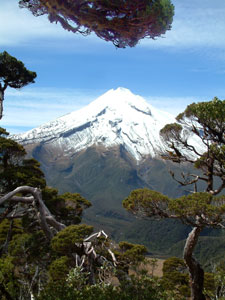 Homage to Fujiyama |
|
|
Despite this distraction, we made it unmuddied to the top of the range and following the ridge along eastward, soon found ourselves at Pouakai hut, overlooking the line of ranges as they circled the ancient crater to the east and looking out to a band of cloud above the flat green landscape of the Taranaki plain to the south. |
|
 A mountain floating on clouds - yeah, right!! (with apologies to Tui) |
|
Day 3 (Pouakai Hut to North Egmont)
|
|
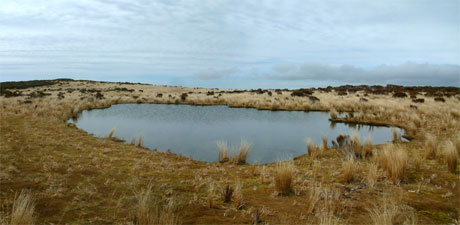 A peaceful tarn amid the tussock and sphagnum |
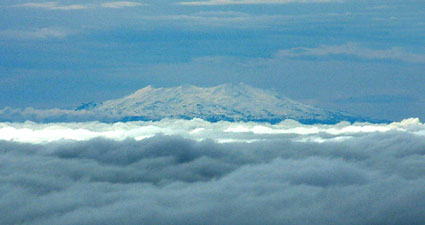 A whiter shade of pale - Ruapehu above the clouds 120 km to the east |
|
Views from Henry Peak 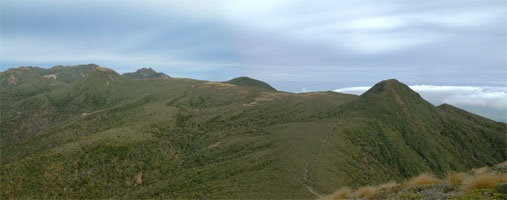 The Pouakai Range |
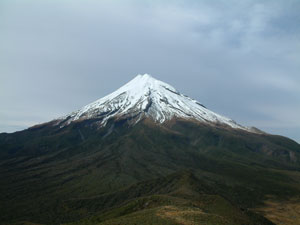 The north face of Taranaki |
 Looking east over the Ahukawakawa Swamp |
|
|
|
|
||
|
On finishing the walk, we drove around to the eastern side of the mountain and spent 2 relaxing days as sole occupants of Konini Lodge, a slightly more upmarket hut (i.e. electricity, heating, refrigerator etc) within the NZ hut system. Installed in our armchairs in front of a large window framing the eastern face of Taranaki with its smaller siamese twin, Fantham's Peak, we were treated to a spectacle of the changing moods of the mountain, from sheets of rain (200mm in 24 hours) to games of peekaboo, as clouds variously covered or uncovered the mountain, and a brilliant sunset as a finale. The rain was not a surprise (the annual fall here is 6-7,000 mm) - the fact that we enjoyed the rain for the first time in New Zealand was! |
|
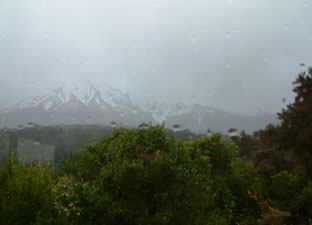 Watching the rainstorms |
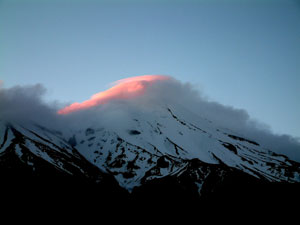 Sunset on the mantle of cloud |
|
 "Goblin" forest near Dawson Falls |
 A misty Dawson Falls |
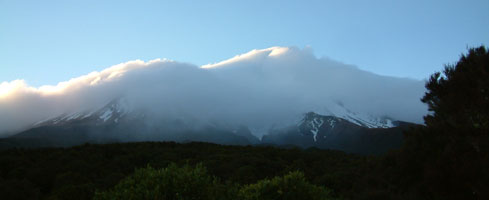 Taranaki wears its white mantle - cloud spilling over from the western side |
When the weather lifted we did a couple of "warm-down" short walks in the misty rain-soaked forest. To celebrate our walk, we treated ourselves to a night out at the Dawson Falls Lodge - garlic and cheese mussels, an enormous minted lamb shank and roast vegetables. home made pavlova, with a fine local riesling and cabernet merlot - delicious! Trampers do not always subsist on a diet of dehydrated vegetables, muesli and pasta. |
|